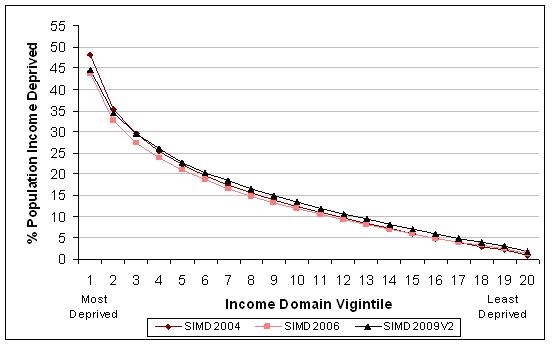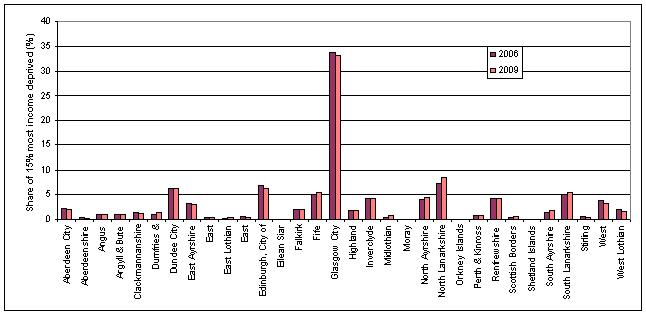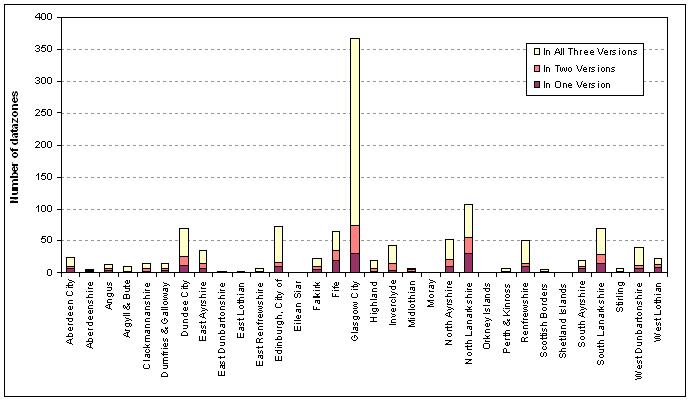Scottish Index of Multiple Deprivation: 2009 General Report
Scottish Index of Multiple Deprivation 2009: General Report
5. Income Domain
5.1. The income domain identifies areas where there are concentrations of individuals and families living on low incomes. This is done by looking at the numbers of people, both adult and children, who are receiving or are dependent on benefits related to income or tax credits. It is not possible to look at actual income as there are no data available on this at datazone level, so the indicators used in this domain are known as proxy indicators. There is a full list of these indicators and the weights that are used in Annex B.
Changes since SIMD 2006
5.2. Five of the six indicators used in this domain have remained the same as in SIMD 2006. The sixth indicator relates to Working and Child Tax Credit and is a new addition to the domain. In the 2004 SIMD data on Disability Tax Credit and Working Families Tax Credit ( WFTC) was used but this was no longer available for the 2006 SIMD. They had been replaced by Working and Child Tax Credit ( WTC and CTC). There was no data available relating to WTC and CTC for the 2006 version of the index so no tax credit data was used. This data is now available and has been reintroduced into the SIMD for 2009. Analysis of the impact of this change to the domain is available as an annex to the SIMD 2009 technical report.
5.3. Despite this change the income domain for 2009 is very highly correlated with the domain from 2006, with a Pearson's correlation coefficient of 0.97.
Income Deprivation across Scotland
5.4. Because the income domain is a count it is possible to comment on the numbers of income deprived people across Scotland and where they are living. Chart 5.1. below shows the percentage of income deprived people in SIMD 2004, 2006 and 2009 by income domain vigintiles.
5.5. In the 2009 SIMD 36% of people living in the 15% most income deprived areas were income deprived compared to 12% in the rest of Scotland. Part of the reason for the fall between SIMD 2004 and SIMD 2006 is because tax credit data was not included in SIMD 2006 as it was not available. This meant low income in work families were not counted as income deprived. Tax credit data has been included in SIMD 2009 which will account for some of the increase. Further analysis of the impact of inclusion of tax credit data is available in the technical report.
5.6. Across Scotland as a whole approximately one in seven people or 15% of the population are income deprived.
Chart 5.1. Percentage of income deprived people in SIMD 2004, 2006 and 2009, by income domain vigintiles

Income Deprivation by Local Authority
5.7. Chart 5.2, below, shows the spread of the 15% most deprived datazones in the Income Domain in each Local Authority for 2006 and 2009. The largest concentrations of income deprivation are in Glasgow for both 2006 (34%) and 2009 (33%). The next largest shares of the 15% most income deprived areas are in North Lanarkshire (8%), Dundee (6%) and Edinburgh (6%).
Chart 5.2: Proportion of datazones in the 15% most deprived on the income domain of SIMD 2006 and 2009 by Local Authority

5.8. Table 5.1. shows the number of income deprived people living in each Local Authority area. It also shows how this count compares nationally as a percentage of the Scottish total. As might be expected Glasgow has the largest share with 19% of the total number of income deprived people in the country. Following the same pattern that is evident in the datazone distribution North Lanarkshire has the next biggest share with 8% but Fife is replaced by Edinburgh in the three Local Authorities with the highest levels of income deprivation.
Table 5.1: Number of Income Deprived People in each Local Authority, SIMD 2009
| Local Authority | Number of Data Zones | Number of income deprived people SIMD 2009 | % of Scotland total |
| Aberdeen City | 267 | 22,170 | 2.8% |
| Aberdeenshire | 301 | 18,960 | 2.4% |
| Angus | 142 | 14,020 | 1.8% |
| Argyll & Bute | 122 | 11,230 | 1.4% |
| Clackmannanshire | 64 | 8,150 | 1.0% |
| Dumfries & Galloway | 193 | 21,250 | 2.7% |
| Dundee City | 179 | 28,990 | 3.7% |
| East Ayrshire | 154 | 21,740 | 2.8% |
| East Dunbartonshire | 127 | 8,910 | 1.1% |
| East Lothian | 120 | 10,660 | 1.4% |
| East Renfrewshire | 120 | 7,920 | 1.0% |
| Edinburgh, City of | 549 | 55,900 | 7.2% |
| Eilean Siar | 36 | 3,960 | 0.5% |
| Falkirk | 197 | 20,890 | 2.7% |
| Fife | 453 | 51,450 | 6.6% |
| Glasgow City | 694 | 149,350 | 19.2% |
| Highland | 292 | 27,250 | 3.5% |
| Inverclyde | 110 | 16,700 | 2.1% |
| Midlothian | 112 | 9,990 | 1.3% |
| Moray | 116 | 9,750 | 1.3% |
| North Ayrshire | 179 | 26,060 | 3.3% |
| North Lanarkshire | 418 | 59,230 | 7.6% |
| Orkney Islands | 27 | 2,040 | 0.3% |
| Perth & Kinross | 175 | 14,090 | 1.8% |
| Renfrewshire | 214 | 27,050 | 3.5% |
| Scottish Borders | 130 | 12,700 | 1.6% |
| Shetland Islands | 30 | 1,860 | 0.2% |
| South Ayrshire | 147 | 16,760 | 2.2% |
| South Lanarkshire | 398 | 46,930 | 6.0% |
| Stirling | 110 | 9,770 | 1.3% |
| West Dunbartonshire | 118 | 19,420 | 2.5% |
| West Lothian | 211 | 24,150 | 3.1% |
| Scotland | 6,505 | 779,300 | 100.0% |
Change over time
5.9. The addition of the tax credit data has resulted in increases in the numbers of income deprived people being counted across the country. However the other indicators within this domain have remained the same. It is therefore possible to look at the underlying data for these indicators to see if there have been real changes in datazones that have moved into and out of the 15% most deprived.
5.10.Between the 2006 SIMD and the 2009 SIMD 114 datazones moved into the 15% most deprived and 114 moved out. All of the datazones that have moved in have seen an increase in the proportion of the population that are income deprived whilst most of the datazones that have moved out have seen decreases even with the inclusion of tax credit data to pick up low income in work families.
5.11.Of the 862 datazones that have remained in the 15% most income deprived between the 2006 SIMD and the 2009 SIMD 776 were also in the 15% most deprived of the income domain in 2004.
5.12. Chart 5.3, below, shows the spread of the 15% most income deprived datazones across each of the local authorities. It also shows how many of the datazones that are in the 15% most deprived have been there for one, two or three versions of the SIMD. Datazones in the 15% most deprived on three updates to the index show concentrations of deprivation still remain.
Chart 5.3: Datazones in the 15% most deprived (Income Domain) in SIMD 2009 showing the numbers of versions of the index for which they've been in the 15% most deprived

There is a problem
Thanks for your feedback